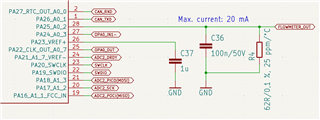Other Parts Discussed in Thread: TPS7B69-Q1
Tool/software:
Hi,
I would like to ask for your help with an issue we've been dealing with for a while now. Many of our regulator units died during testing (sometimes simply while laying on a table with nothing connected to them, apart from power and CAN bus).
Brief device description:
Electric water heater regulator, communicating over CAN bus.
2 PT100 temperature sensors, a flowmeter and a 3-phase triac regulator are connected to the device via a screw terminal block.
The common factor among all of the cases seems to be that after the unit gets destroyed, VDD and pin PA25 are connected to ground via a low impedance inside the MCU - most of the time it's not a dead short (10s of ohms), but VDD and PA25 are virtually shorted together. This leads me to believe, that one of the protective diodes on the pin is destroyed. I tried testing the pin with mild electrostatic discharges, but this had no effect. Connecting 24 V to the pin resulted in it shorting to VDD, essentially simulating the above mentioned state.
This pin is used as an input to the ADC and is a part of a 4 - 20 mA current loop, sensing the output of the flowmeter. The issue sometimes happens even when there's nothing connected to the terminal (FLOWMETER_OUT in the schematic).
I plan to test it with a more powerful static discharge tomorrow, but apart from that, I'm running out of ideas what could be the cause of this problem.
Is there any possibility, that a misconfigured pin can lead to a situation like this?


